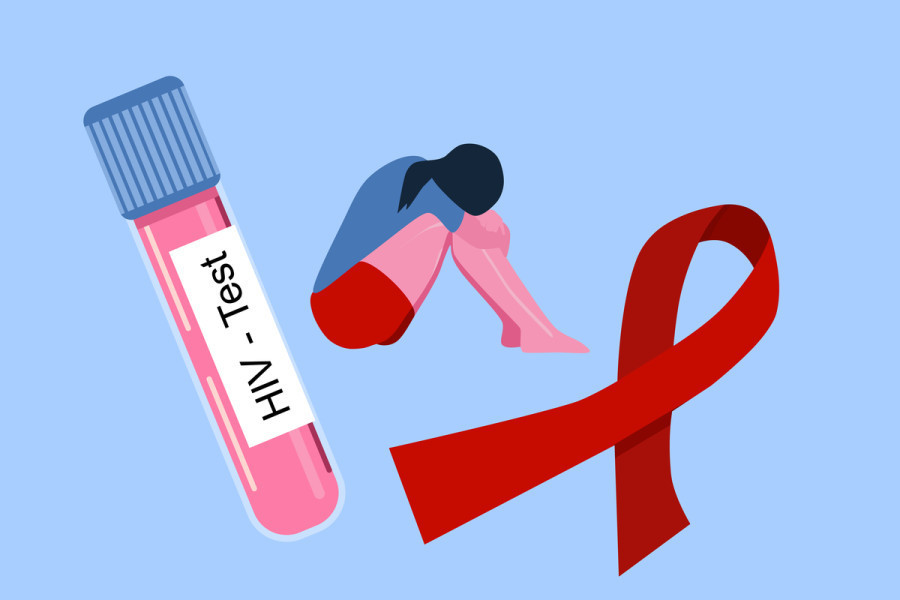Health
HIV infections and deaths decline, but stigma runs deep
Every day, at least one person gets infected with HIV in Nepal.
Post Report
A few days ago, a 50-year-old from Kaski district reached the emergency ward of a local hospital for treatment of abdominal pain. The woman, who was living with HIV, told the doctor about her condition before the start of treatment.
“Then the behaviour of doctors and other health workers changed abruptly,” Puja Kunwar, programme manager of YKP Lead Nepal, quoted the woman as saying. “They also asked her to purchase separate gloves, masks and other items for the health workers. The behaviour of the health workers towards the woman, who has been working to lessen stigma and discrimination for the last two decades, was outrageous.”
Although new data provided by the Ministry of Health and Population shows there has been satisfactory progress in reducing the HIV infection rate and deaths in Nepal, deep-rooted social stigma has not lessened as expected.
YKP Lead Nepal, an organisation formed to engage with young people who use drugs, men who have sex with men, people living with HIV/AIDS, migrant workers, and sex workers, says that infected people are still being stigmatised in society.
“Infected children are denied their rights to enroll in schools; adults are losing jobs solely because of their HIV status,” said Kunwar. “And these problems are not limited to a particular place, but are pervasive across the country. Due to similar discriminatory behaviours, many infected people do not dare to reveal their HIV status to family members and society.”
The deep-rooted stigma against the disease is the main reason for concealing the disease condition, avoiding testing and treatment for a long time, or discontinuing medication, according to experts.
They say that infected people cannot tell their spouse(s) about their disease conditions, and it becomes equally difficult for their spouses to readily accept the situation. As a result, many people conceal their disease condition, transmit the disease to their partners, and seek treatment only after their health deteriorates, say experts.
“Even though the infection rate and deaths from HIV have declined substantially, we have not been able to make progress in lessening stigma and discrimination,” said Lok Raj Pandey, information officer at the National Centre for AIDS and STD Control.
“Stigma against HIV-infected people is deep-seated in communities, which will not end easily.”
It is also possible for HIV-infected women to give birth to a baby who does not have HIV. Similarly, two HIV-positive parents can also have an HIV-negative child, provided that the infected woman starts antiretroviral therapy before pregnancy.
Experts say one can also avoid HIV infection by taking pre-exposure prophylaxis within 72 hours of having unsafe sex.
Experts say people infected with HIV can live healthy and normal life spans if they get proper treatment. For this, treatment should be started early, and medicines prescribed by doctors should be taken regularly.
According to data provided by the Centre, the HIV infection rate in Nepal in 2023 declined by 91 percent compared to 2000. Last year, only 457 people tested positive for HIV, and 231 were estimated to have succumbed to the disease. In the year 2000, some 5,100 infected people were detected, and in 2010, a total of 1,700 deaths were recorded, according to officials.
Improved treatment is credited with the decline in the infection and death rate. Doctors say those who regularly use antiretroviral medicine don't pass the disease to others.
The health ministry provides antiretroviral therapy free of charge to all people living with HIV. Currently, 25,728 people are receiving antiretroviral treatment (ART).
There are 92 operational sites and 46 ART dispensing centres throughout the country.
It is estimated that 30,300 people were infected with HIV in Nepal until 2023. Every day, at least one person gets infected with HIV in the country.




 13.12°C Kathmandu
13.12°C Kathmandu













